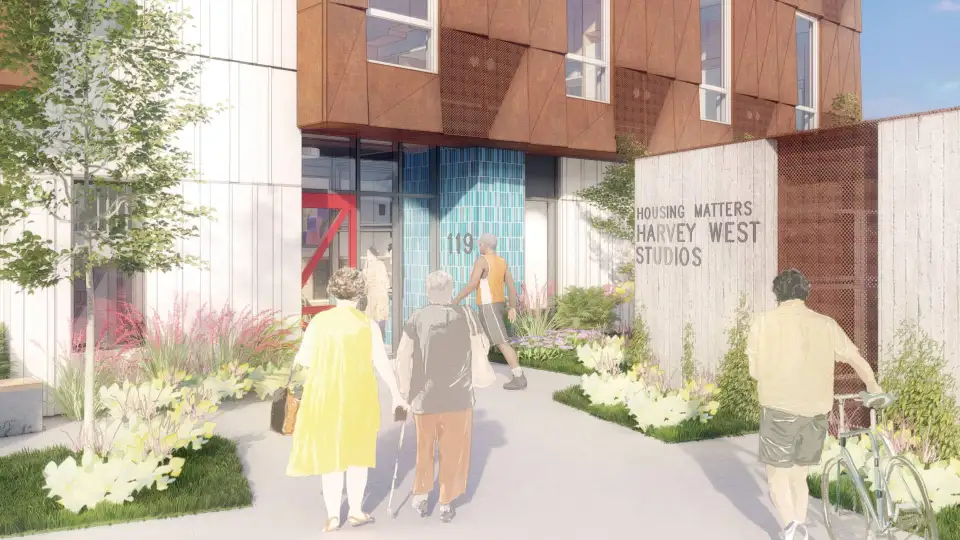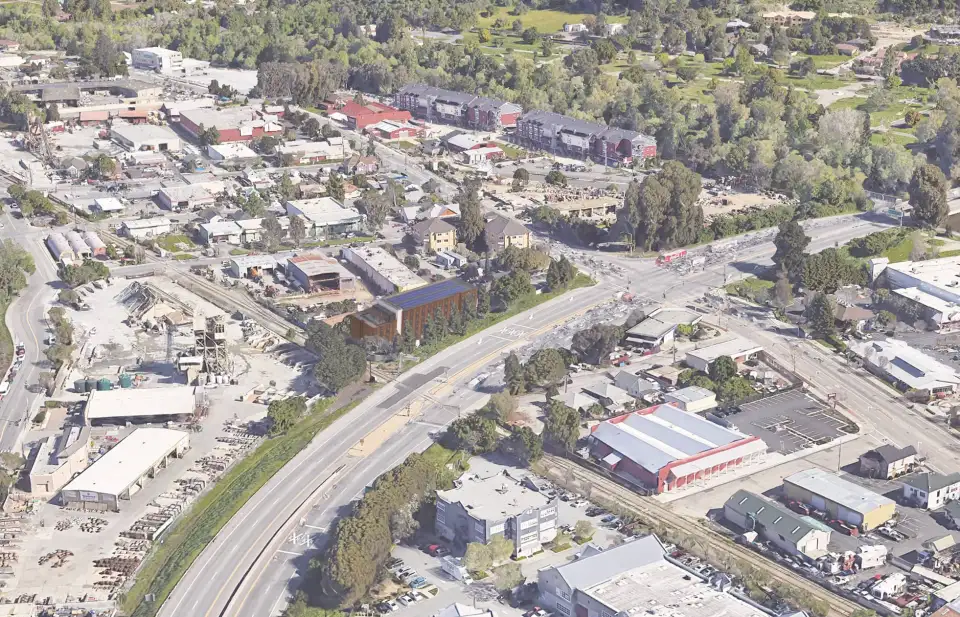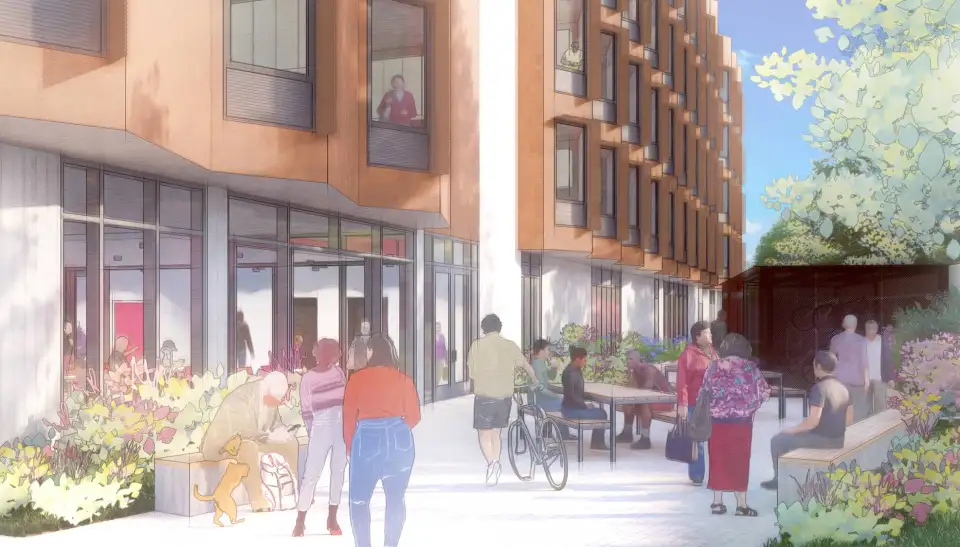
Santa Cruz, a coastal city in California known for its beautiful beaches and mild climate, also has a well-earned reputation for its limited and expensive housing options. As is the case in many California cities, a tight housing market has translated into very few options for low-income residents and a fluctuating, but persistent, population experiencing homelessness. Every two years Santa Cruz County conducts counts of its unhoused population, and in its most recent survey the county concluded there were roughly 2,167 people experiencing homelessness in the community, 403 of whom were experiencing chronic homelessness. To help address this housing dearth, Harvey West Studios—120 units of permanent supportive housing for those experiencing chronic homelessness, a project led by local non-profit Housing Matters—will break ground in spring 2022.
Harvey West, a five-story all-electric building, will feature support services on the ground floor, including recuperative care and behavioral health clinics, with 120 studio apartments plus one manager’s unit on the upper four floors. The project is targeting PHIUS+ performance for the residences. Landscaped spaces and a rooftop deck are intended to bring a restorative quality to the site, while also creating a locus for intentional community and staff interaction. In partnership with Housing Matters, New Way Homes, and the Housing Authority of Santa Cruz County, David Baker Architects (DBA) is guiding the design of this landmark project. High-quality modular construction will be used to achieve the passive design targets, shortening the time to build without compromising quality.

“It’s great the client wanted an ambitious project with low operating expenses,” says Daniel Simons, a principal at DBA. Having those goals set for the project made targeting Passive House performance an easier push, Simons explains, saying that DBA was excited to incorporate passive goals into the program. DBA has extensive experience in designing sustainable affordable housing, and has designed for modular construction, but this is its first project combining modular construction and Passive House performance into one design.
As the site had constraints, some design choices were limited by the need to fit the 121 units and other program requirements into a tight square footage. Early in the process, DBA utilized the state density bonus, granted under Senate Bill 35, to add two additional floors to the proposed building and expand its area, almost doubling the site’s yield. Altogether, DBA managed to layer multiple priorities into the building’s form—aided by passive design principles. “What was most important for us was the residents’ health and wellness, especially around air quality,” says Will Bloomer, the project’s lead architect. “This population has health vulnerabilities. Creating a safe space for the residents was critical.” The Santa Cruz area has suffered through three severe smoke events in the most recent four years. Fortunately, passive requirements regarding the airtightness of a structure and the supply of continuous filtered ventilation worked in tandem with DBA’s goals. And, to strengthen the occupants’ connection to nature, the units’ operable windows are oriented as much as possible to capture views toward the ocean.
A relatively simple form factor is a plus for passive construction, and one that also helps when designing with modular components in mind. Indeed, modular construction works best with a project that is both straightforward and has repetitive elements. For Harvey West, each studio will be one modular unit, all of which are being built at FactoryOS, located roughly 100 miles north on the site of the former Mare Island Naval Shipyard in Vallejo. Harvey West is the second permanent supportive housing that DBA has designed using FactoryOS modules—and there is another one in the early planning stage—and with repetition comes rewards. “Each one learns from the other and reuses information in terms of unit sizes and layouts,” Bloomer explains.
“We have had a long relationship with FactoryOS, as its founders are long-time clients of ours,” Simons adds. “They are excited about doing a Passive House project and have been engaged in the process from early on.” DBA is working with a group from FactoryOS to modify its standard quality assurance processes to ensure the rigorous passive requirements will be met. The details for ensuring airtight connections among the modules on site are still being worked out, as are the connections from the second floor to the ground-floor concrete podium that will house the support services. At press time, the client had not yet decided how much of the ground-floor level will be Phius certified.


While Harvey West and DBA’s previous affordable housing projects share many similarities, there are some significant differences needed to meet this project’s goals. DBA has been working with RDH Building Science as its Phius consultant to optimize the envelope and mechanical systems. In keeping with Phius requirements, the Harvey West project will rely on ERVs—one per residential floor—to supply constant fresh air while minimizing heat gains and losses through the ventilation system. Another difference this project will feature is a layer of continuous exterior insulation—but only one inch. At present a mineral wool product is specified.
WUFI modeling is showing that double-pane windows will be sufficient to meet the heating and cooling criteria. Custom-designed folded metal panels will shade the south-facing windows, while a vertical shade on the western facade will reduce overheating. To ensure that the building’s occupants stay comfortable, RDH ran an overheating analysis for Santa Cruz’s current climate and future climate scenarios. “Santa Cruz has a wonderful climate when looking at current conditions, but what we learned is we really do want conditioned air for future proofing,” says Bloomer. Each studio apartment will be equipped with its own packaged terminal air conditioner (PTAC) unit. A VRF system will be used to condition the ground-floor spaces.
Two Lochinvar heat pump water heaters, installed on the roof, will supply the building’s domestic hot water. The residences are so small that all of the plumbing runs will be in small shafts that project into the corridor.
While DBA’s ambitions are centered on creating buildings that work to mitigate climate change, this project also realizes other DBA priorities. “We want people to notice the building, and for it to bring visibility to housing scarcity and homelessness,” Bloomer points out. Situated at the intersection of two busy roadways, the building will inevitably draw passersby’s attention. Its attractive, harmonious façade hopefully will inspire appreciation and pave the way for additional efforts to address housing shortages.
David Baker Architects’ Sustainability Commitment
"DBA is dedicated to the understanding that the housing crisis and the climate crisis should be addressed as one problem,” explains Katie Ackerly, principal and sustainable design lead at DBA. Toward that goal, DBA developed its own framework to ensure that its projects are guided by critical questions that reflect the most important long-term needs of a community (see Figure 1). In her work guiding DBA’s sustainability progress, Ackerly has been posing the question: Is it time to shift the emphasis of sustainable design away from making incrementally better buildings and toward deconstructing barriers that stand in the way of stronger communities and ecologies? “If we take our story of “co-benefits” seriously,” Ackerly says, “perhaps we could lead with human needs—like resilience, refuge, health, access, and ease—and allow carbon savings to be the inevitable co-benefit, garnering broader acceptance, mobilization, and scalability of climate-positive housing solutions.”
Aiming for consistently improving the firm’s portfolio-based track record, DBA has been tracking actual energy use of those completed projects whose data it can access (see Figure 2), in keeping with the AIA’s 2030 commitment. Edwina Benner Plaza stands out from the crowd both for its close match between actual and modeled energy use and for its substantively lower EUI than the other built projects. It is also one of the first all-electric affordable housing projects in California—which partially explains the match-up. “Edwina Benner Plaza benefited from being part of a California Energy Commission heat pump water heating demonstration project,” explains Ackerly.
Being part of a demonstration project meant that DBA was able to take advantage of technical assistance on the front end—optimizing the design of a novel water heating system, including the plumbing distribution—and monitoring after the project’s construction. Fine tuning the water heating system included programming the water heater’s storage and run times to avoid operating during peak hours when electricity is most expensive, thereby saving money for the client and increasing acceptance of a new technology. The demonstration showed that post-construction commissioning, which is a rare practice in the affordable housing sector, is as valuable, if not more valuable, than new technology. “The commitment to understand what is happening impacts climate adaptation and mitigation in our community-based housing,” Ackerly notes.
One technological change is significantly affecting multifamily housing in California: all-electric central plants. “We are not seeing any new projects now that use gas, and that’s news,” Ackerly points out. Only a year ago a major affordable housing client backed out of an all-electric development, because it was still too new for them, but 2021 has already brought a greater acceptance of the fuel switch to California’s affordable housing market.